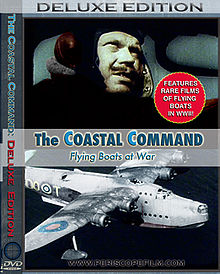- Coastal Command (film)
-
Coastal Command 
Directed by J. B. Holmes Music by Ralph Vaughan Williams Release date(s) 1942 Running time 73 minutes Country UK Language English Coastal Command is a 1942 British film made by the Crown Film Unit for the Ministry of Information. The movie, distributed by RKO, dramatised the work of RAF Coastal Command. It was made under the supervision of Ian Dalrymple, with the full cooperation of the Royal Air Force and the Royal Navy. The participants of the movie were active RAF officers, NCOs and aircrew, and RN officers, and included pilot Roger Hunter and Flight Sergeant Charles Norman Lewis; the latter of whom was killed in World War II.[1] The performances were generally well-received.[citation needed] Coastal Command is notable for its score by Ralph Vaughan Williams.
Contents
Plot
Coastal Command is a documentary-style account of the Shorts Sunderland and PBY Catalina flying boats during the Battle of the Atlantic. The film includes real footage of attacks on a major enemy ship by Hudson and Halifax bombers based in Iceland. Later, the film depicts a routine sea patrol, in which a Sunderland flying boat flies over a convoy and bombs a German U-boat. Two versions of the film were made, one featuring an explanatory voice-over. In this version, the film ends with a combined air attack on an enemy cruiser caught away from its base. The Sunderland's crew returns to England, mission accomplished, and with a wounded crew member in stable condition. In the second, slightly longer version of the film, the Sunderland crew returns home after the successful attack on the cruiser, and the wounded crew member is hospitalized. After a visit to the hospital, the film ends as the Sunderland crew is informed they will be re-deployed to West Africa, to begin a new mission.
Cast and credits
- Director - J. B. Holmes.
- Cameraman - Jonah Jones.
Reviews
After its release in the United States on 18 April 1944, a New York Times reviewer wrote that it suffered in comparison with the similar Memphis Belle documentary.[2]. However, he did write that
Many of the individual glimpses in this film are intriguing to the eye, and the whole conveys an academic notion of the personal and organizational problems of the Coastal Command. But the obvious studio-staging of much of the action in which personnel is involved and the scattered arrangement of continuity drain the film of sharp immediacy and drive. Because it jumps its scenes from one plane to another, from shore to plane—and even a few times to the Nazi ship—without adequate definition, the spectator is forced to an objective point of view. A sense of artificial construction is plainly inevitable. Thus suspense and excitement are lacking. The mood becomes fitful and blasé.
References
Bibliography
- Neil Owen, Royal Air Force Station Oban 1939-45: A History of Flying Boat Operations
- Roger Manvell, "Films and the Second World War" (J.M. Dent & Sons, 1974)
External links
Categories:- English-language films
- 1942 films
- British films
- World War II films made in wartime
- British documentary films
- Black-and-white films
- British World War II propaganda films
- Aviation films
- Film scores by Ralph Vaughan Williams
- Crown Film Unit films
Wikimedia Foundation. 2010.
